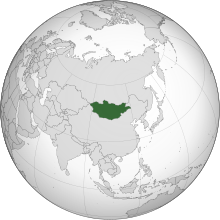Templat:Mongolia infobox
Tampilan
- ^ "Official Documents to be in Mongolian Script". UB Post. June 21, 2011. Diarsipkan dari versi asli tanggal November 1, 2011. Diakses tanggal 2010-07-11.
- ^ a b c "Mongolia". The World Factbook. CIA. Diarsipkan dari versi asli tanggal July 3, 2015. Diakses tanggal August 9, 2015.
- ^ Shugart, Matthew Søberg (September 2005). "Semi-Presidential Systems: Dual Executive and Mixed Authority Patterns" (PDF). Graduate School of International Relations and Pacific Studies. Diarsipkan dari versi asli (PDF) tanggal August 19, 2008. Diakses tanggal 21 February 2016.
- ^ Shugart, Matthew Søberg (December 2005). "Semi-Presidential Systems: Dual Executive And Mixed Authority Patterns" (PDF). French Politics. 3 (3): 323–351. doi:10.1057/palgrave.fp.8200087. Diarsipkan (PDF) dari versi asli tanggal March 4, 2016. Diakses tanggal February 21, 2016.
Even if the president has no discretion in the forming of cabinets or the right to dissolve parliament, his or her constitutional authority can be regarded as 'quite considerable' in Duverger’s sense if cabinet legislation approved in parliament can be blocked by the people's elected agent. Such powers are especially relevant if an extraordinary majority is required to override a veto, as in Mongolia, Poland, and Senegal.
- ^ Odonkhuu, Munkhsaikhan (February 12, 2016). "Mongolia: A Vain Constitutional Attempt to Consolidate Parliamentary Democracy". ConstitutionNet. International IDEA. Diarsipkan dari versi asli tanggal February 25, 2016. Diakses tanggal February 21, 2016.
Mongolia is sometimes described as a semi-presidential system because, while the prime minister and cabinet are collectively responsible to the SGKh, the president is popularly elected, and his/her powers are much broader than the conventional powers of heads of state in parliamentary systems.
- ^ "National Statistical Office of Mongolia". UBSEG.GOV.MN. Diarsipkan dari versi asli tanggal April 15, 2016.
- ^ a b Apr 2016
- ^ a b c d "World Economic Outlook Database, October 2018". IMF.org. International Monetary Fund. Diakses tanggal 24 February 2019.
- ^ "Gini Index". World Bank. Diarsipkan dari versi asli tanggal June 8, 2014. Diakses tanggal March 2, 2011.
- ^ "Human Development Report 2018 – "Human Development Indices and Indicators"" (PDF). HDRO (Human Development Report Office) United Nations Development Programme. hlm. 22–25. Diakses tanggal 14 September 2018.
- ^ "Waktu Standar Mongolia adalah GMT (UTC) +8, beberapa wilayah Mongolia menggunakan GMT (UTC) +7". Time Temperature.com. Diarsipkan dari versi asli tanggal October 13, 2007. Diakses tanggal September 30, 2007.
- ^ "Perubahan jam di Ulaanbaatar, Mongolia". timeanddate.com. Diarsipkan dari versi asli tanggal March 25, 2015. Diakses tanggal March 27, 2015.







